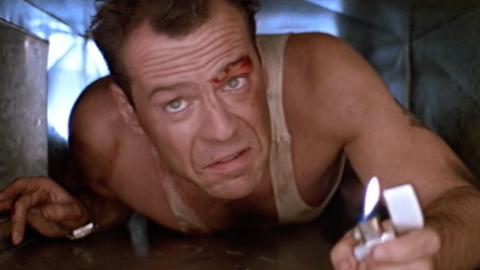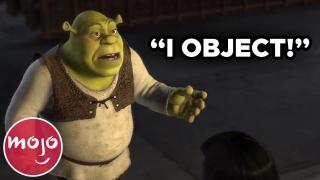Top 10 Movie Logics That Doesn't Make Sense

Even in the best of films, there are things that defy reason. Join http://www.WatchMojo.com as we count down our picks for the Top 10 Examples of Movie Logic that Make No Sense. For this list, we'll be scouring various films throughout history to find those tropes and trends that seem nonsensical or bizarre when examined closely.
Special thanks to our users MikeyP and Rasec Delos Reyes for submitting the idea on our Interactive Suggestion Tool at http://www.WatchMojo.comsuggest
Top 10 Movie Logics That Doesn't Make Sense
Top 20 Movie Logics That Don't Make Sense
Even in the best of films, there are things that defy reason. Join http://www.WatchMojo.com as we count down our picks for the Top 10 Examples of Movie Logic that Make No Sense. For this list, we’ll be scouring various films throughout history to find those tropes and trends that seem nonsensical or bizarre when examined closely. Whether it’s the physics of action films, the suspense-building elements of horror cinema, or simply a recurring gag in Hollywood productions, we find these raise the most eyebrows in terms of logical leaps.
#10: Destroy the Screen; Destroy the Computer
Need to ensure a computer system is completely and utterly wrecked? Just destroy the screen, and be on your merry way. More than a few films operate under the logic that a monitor is the same thing as a computer – perhaps because the monitor is how information on a computer is displayed, or due to early computers such as the Commodore PET containing both a monitor and vital internal parts. Whatever the inspiration for this line of thinking, it’s still a bit ridiculous.
#9: One Match to Light It All
Top 10 Lizzie McGuire Movie Moments That Make No Sense
Dark corridors and chambers beware – somebody’s got a match. At first glance, using a match to light one’s way seems reasonable enough… until the question of how a tiny lit match can illuminate vast spaces comes up. In spite of their small size and limited ability to produce light, matches in cinema are astoundingly effective. Be it a tight ventilation shaft or the location of a square dance, nothing appears immune to this tiny fiery object.
#8: Last-Second Bomb Disarmament
Top 10 Wedding Tropes That Make NO Sense
Thank goodness for split-second timing and criminal negligence. Often in film, when the prospect of a bomb threat comes up, the heroes do everything in their power to stop the bomb from detonating – and at the very last moment, they typically succeed. However, this raises a key question: why would anyone put a timer on their bomb, if they could just detonate it right away? It’s a careless oversight that costs villains victory at the last second, and it’s usually completely unnecessary to their plan.
#7: Keyboards are the Way of the Future
Perhaps computer mice are a foreign concept in films. At least, that’s what we figure based on the logic applied in films, cause it seems that accomplishing anything meaningful on a computer can only be done by frantic typing on the keyboard, with mice and other peripherals being of lesser importance – if they appear at all. Montgomery Scott typing out the formula for transparent aluminum in “Star Trek IV,” for example, is entirely based around keyboard use. Though some computer users in reality may be able to type that fast, it usually results in spelling errors – to say nothing of the importance that computer mice possess.
#6: Bullets Throw People
We don’t claim to be scientists, but we’re reasonably sure bullets don’t work this way. Yet action cinema continues to operate under the belief that when a person gets shot, his or her body gets thrown a fair distance. From the Terminator being knocked back with a shotgun blast, to Agent Jones getting shot in the head in “The Matrix,” there’s no shortage force of bodies sent flying from gunshots. Though it makes for impressive imagery, it defies logic.
#5: Static = Death
Walkie-talkies are wonderful things, but beware if the person on the other end stops speaking. Because, in movies, if you get static, that means the other person’s dead. We’re not precisely sure where this line of logic originated from, but it certainly crops up in a variety of places – typically to raise suspense and make people, both in the film and in the audience, feel uneasy. It’s hard to deny that it’s effective, but there could be any number of reasons why static comes up in a radio transmission. Besides, to transmit static the person on the other end needs to be pressing the button, and that’s hard to do if they are no longer living...
#4: Landing in Water Is Like Landing on a Cloud
Water may seem safe, but in situations involving a long fall it’s a deadly adversary. If ever a character needs to make a quick escape, they elect to jump from a great height into a body of water; the presumption more-than-likely being that the water will cushion their fall. Unfortunately, this is not the case, at least IRL – hitting the water at 80mph is like hitting a concrete wall, and the average human body falls at 120 miles per hour. This fact makes scenes such as James Bond’s long drop in the opening of 2012’s “Skyfall” increasingly unreal.
#3: Just a Concussion; No Worries
Top 10 Movie Songs That Always Make Us Cry
Suffer a potentially debilitating head injury? Not a problem – just walk it off. Yes, concussions seem to not have the same impact in films as in reality; rather than causing disorientation or worse symptoms, they instead come across as just another mild wound for heroes and heroines to overcome. Consider the frequency with which Marty McFly gets hit in the head over the course of the “Back to the Future” films: at least once per movie, Marty is rendered unconscious yet recovers with no apparent long-term damage. It’s odd to see, to say the least.
#2: Wait Your Turn to Fight
Incredibles 2 vs. The Incredibles: Worth the Wait? - Mojo @ the Movies
Chivalry is not dead, it seems. Should a hero or heroine be faced by a group of foes, Hollywood says, then it only makes sense for the enemies to attack one-by-one. Is it because rushing the hero all at once is unsportsmanlike? Is it that the villains believe one single warrior can defeat the hero? Or is it just an unwillingness to retreat and think of a new plan? We’re not sure, but it seems arbitrary and entirely unnecessary to have an attack force waiting for their turn to fight. Before we unveil our top pick, here are a few honorable mentions: - All Computers Have An Inconveniently-Located Manual Override - When a Car Door Locks, There’s No Escape - Parking Spots Are Always Conveniently Available Right Out Front - During Phone Calls, People Never Say Goodbye - People Can Just Sneak Past Airport Security for a Final Farewell
#1: Everything! Must! Explode!
Top 10 Things in the MCU That Make No Sense
From shooting cars to blowing up spaceships, it seems like objects in films are predestined to burst into flames. Explosions are firmly established in cinema as a signature form of spectacle, but increasingly it seems as though everything is primed to blow up. Whether it’s sand dunes and robots, ships in the vacuum of space or entire planets, explosions are more or less guaranteed to occur. It’s fun to watch unfold, but we’re certain the real world isn’t that prone to spontaneous explosions. Probably. We hope. Do you agree with our list? What movie logic doesn’t make sense to you? For more logical Top 10s published daily, be sure to subscribe to WatchMojo.com.


 1
1
 0
0
 flagged
flagged






